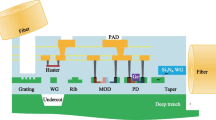Abstract
Nanoelectronics constructed by nanoscale devices seems promising for the advanced development of integrated circuits (ICs). However, the lack of computer aided design (CAD) tools seriously hinders its development and applications. To investigate the cell mapping task in CAD flow, we present a genetic algorithm (GA) based method for Cmos/nanowire/MOLecular hybrid (CMOL), which is a nanohybrid circuit architecture. By designing several crossover operators and analyzing their performance, an efficient crossover operator is proposed. Combining a mutation operator, a GA based algorithm is presented and tested on the International Symposium on Circuits and Systems (ISCAS) benchmarks. The results show that the proposed method not only can obtain better area utilization and smaller delay, but also can handle larger benchmarks with CPU time improvement compared with the published methods.
Similar content being viewed by others
References
Haselman M, Hauck S. The future of integrated circuits: A survey of nanoelectronics. Proceedings of the IEEE, 2010, 98(1): 11-38.
Wang W, Liu M, Hsu A. Hybrid nanoelectronics: Future of computer technology. Journal of Computer Science and Technology, 2006, 21(6): 871-886.
Likharev K K. Hybrid CMOS/nanoelectronic circuits: Opportunities and challenges. Journal of Nanoelectronics and Optoelectronics, 2008, 3(3): 203-230.
Abid Z, Barua M, Alma'aitah A. Design of a transmission gate based CMOL memory array. IET Micro & Nano Letters, 2008, 3(3): 70-76.
Strukov D B, Likharev K K. Defect-tolerant architectures for nanoelectronic crossbar memories. Journal of Nanoscience and Nanotechnology, 2007, 7(1): 151-167.
Strukov D, Mishchenko A. Monolithically stackable hybrid FPGA. In Proc. DATE, Dresden, Germany, Mar. 8-12, 2010, pp.661-666.
Strukov D B, Likharev K K. CMOL FPGA: A reconfigurable architecture for hybrid digital circuits with two-terminal nanodevices. Nanotechnology, 2005, 16(6): 888-900.
TÜrel Ö, Lee J H, Ma X, Likharev K K. Architectures for nanoelectronic implementation of artificial neural networks: New results. Neurocomputing, 2005, 64: 271-283.
Strukov D B, Likharev K K. CMOL FPGA circuits. In Proc. Int. Conf. Computer Design, Las Vegas, USA, June 26-29, 2006, pp.213-219.
Betz V, Rose J. VPR: A new packing, placement and routing tool for FPGA research. In Proc. the 7th International Work-shop on Field-Programmable Logic and Applications, London, UK, Sep. 1-3, 1997, pp.213-222.
Hung W N N, Gao C, Song X, Hammerstrom D. Defect-tolerant CMOL cell assignment via satisfiability. IEEE Sensors Journal, 2008, 8(6): 823-830.
Kim K, Karri R, Orailoglu A. Design automation for hybrid CMOS-nonoelectronics crossbars. In Proc. IEEE International Symposium on Nanoscale Architectures, Santa Clara,USA, Oct. 21-22, 2007, pp.27-32.
Chu Z, Xia Y, Wang L, Hu M. CMOL cell assignment based on dynamic interchange. In Proc. the 8th ASICON, Chang-sha, China, Oct. 20-23, 2009, pp.921-924.
Xia Y, Chu Z, Hung W N N, Wang L, Song X. CMOL cell assignment by genetic algorithm. In Proc. the 8th NEWCAS, Montreal, Canada, June 20-23, 2010, pp.25-28.
Snider G S, Williams R S. Nano/CMOS architectures using a field-programmable nanowire interconnect. Nanotechnology, 2007, 18(3), Article No. 035204.
Xia Q, Robinett W, Cumbie M W, Banerjee N, Cardinali T J, Yang J J, Wu W, Li X, Tong W M, Strukov D B, Snider G S, Medeiros-Ribeiro G, Williams R S. Memristor-CMOS hybrid integrated circuits for reconfigurable logic. Nano Letters, 2009, 9(10): 3640-3645.
Tu D, Liu M, Wang W, Haruehanroengra S. 3D CMOS/Molecular hybrid circuits. Journal of Nanoscience and Nanotechnology, 2009, 9(2): 1015-1018.
Tu D, Liu M, Wang W, Haruehanroengra S. Three-dimensional CMOL: Three-dimensional integration of CMOS/nanomaterial hybrid digital circuits. IET Micro & Nano Letters, 2007, 2(2): 40-45.
Chen G, Song X, Hu P. A theoretical investigation on CMOL FPGA cell assignment problem. IEEE Transactions on Nanotechnology, 2009, 8(3): 322-329.
Xia Y, Almaini A E A. Genetic algorithm based state assignment for power and area optimisation. IEE Proceedings — Computers and Digital Techniques, 2002, 149(4): 128-133.
Sivanandam S N, Deepa S N. Introduction to Genetic Algorithms. Heidelberg: Springer, 2008.
Sentovich E M, Singh K J, Lavagno L et al. SIS: A system for sequential circuit synthesis. Technical Report UCB/ERL M92/41, University of California, Berkeley, 1992.
Strukov D, Likharev K. A reconfigurable architecture for hybrid CMOS/nanodevice circuits. In Proc. the 14th ACM/SIGDA Int. Symp. Field Programmable Gate Arrays, Monterey, USA, Feb. 22-24, 2006, pp.131-140.
Author information
Authors and Affiliations
Corresponding author
Electronic supplementary material
Below is the link to the electronic supplementary material.
Rights and permissions
About this article
Cite this article
Chu, ZF., Xia, YS. & Wang, LY. Cell Mapping for Nanohybrid Circuit Architecture Using Genetic Algorithm. J. Comput. Sci. Technol. 27, 113–120 (2012). https://doi.org/10.1007/s11390-012-1210-7
Received:
Revised:
Published:
Issue Date:
DOI: https://doi.org/10.1007/s11390-012-1210-7




